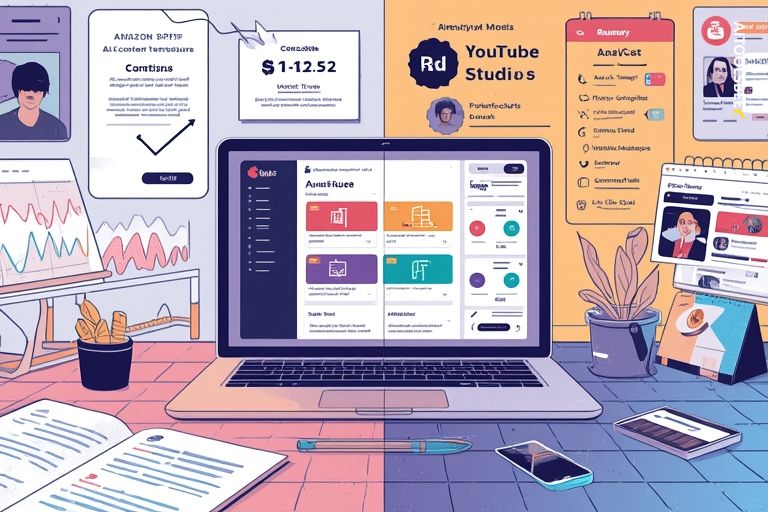
Platforms tighten the 2025 playbook for AI passive income
As 2025 begins, the quest for passive income built with text, image, audio, and video tools is being reshaped by basic rules that reward transparency and punish copycat work. Platforms ask creators to disclose machine assistance and secure consent when voices are cloned, which makes policy literacy as important as production skill. The reward structure now favors originality and discoverability rather than volume, and it links long term earnings to trust.
For solo builders the attraction is obvious. Low overhead, instant global distribution, and customer expectations for downloadable convenience make digital goods easy to test and scale, yet the safer strategy is to pick one core stream and one supplementary stream so revenue is not tied to a single platform. The choice of one time sales, bundles, or subscription access to new templates determines how predictable passive income becomes.
For creators shipping books, guides, or templates, a five day blueprint turns vague ambition into output. Day zero is niche and keyword research to align product ideas with search intent and platform taxonomy, which sets the stage for demand capture without paid lift. The first two days focus on drafting a table of contents with ChatGPT, assembling chapter summaries and FAQs, generating interior text, and then editing for accuracy and voice, with covers or printable pages built in Midjourney or Canva AI under clear ownership or licensing so that passive income is not threatened by disputes.
The third day is devoted to compliance and polish, including a plagiarism check with a Copyscape or Turnitin style service and a final proofread that might be supported by Grammarly, followed by metadata preparation with a title, a subtitle, five keywords, and a two hundred to four hundred word description. The fourth day is upload to Gumroad, Etsy, or Amazon KDP where AI content must be disclosed during KDP submission using the platform declaration fields, and the fifth day is launch with three to five promotional images, one pinned Pinterest post, one Instagram post, and a small five to twenty dollar ads test, then ongoing monitoring of conversion rates to add variations, bundles, and seasonal designs that extend passive income.
Video creators face a similar shift as YouTube tightens rules on mass produced or inauthentic material and directs rewards to uploads that add original value rather than repetitive spam, while payouts continue to flow through AdSense, memberships, and sponsorships. Successful faceless channels build evergreen, searchable libraries, and a typical pipeline by week two includes scripts generated with ChatGPT and then tightened by a human editor, voiceovers recorded with ElevenLabs, Murf, or PlayHT only when the right to the voice has been secured, visuals blended from Pexels and AI B roll from Runway with simple motion graphics in CapCut or Descript, and editing with accurate captions in Descript or Premiere so the channel can compound passive income.
By week three the emphasis turns to upload craft, with search friendly titles and descriptions, fifteen tags, an eye catching thumbnail, a steady cadence of two to three videos per week, and pinned comments with timestamps to raise watch time. For print on demand and stock assets the appeal is no inventory and low risk, but creators must observe platform rules along with any IP, celebrity, or brand restrictions, and they should check Shutterstock, Adobe, and Envato terms for AI content and disclosure while voice providers increasingly require consent and forbid cloning without permission so that passive income is not jeopardized by takedowns.
There is also a quieter engine that keeps text based affiliate sites in good standing and it begins with restraint, because commissions scale from organic search only when articles are edited by humans and guided by a coherent SEO strategy. Search engines and ad networks penalize low value AI mass content, which is why creators add original testing, photos, or interviews, and many rely on reusable templates such as an ebook outline prompt, a listing disclosure format for Etsy or KDP, and a video structure checklist to maintain standards while still accelerating passive income.
The competitive map is clarifying as the toolchain specializes, with ChatGPT and Claude for text, Canva AI, Midjourney, and Leonardo for visuals, and Grammarly and Copyscape for polish, while Runway fills the synthetic footage niche and CapCut and Descript fight to simplify the edit. The advantage now tilts toward creators who codify transparent, repeatable workflows that satisfy platform policies, a pattern that could help founders in the UK and other hubs build lean content businesses that appeal to investors looking for recurring revenue and disciplined growth in passive income. The broader signal is that enterprise content will be judged by originality and compliance as much as creativity, an alignment that hints at a more durable phase for automation.

From rising startups to breakthrough innovations, she connects the dots across the global AI ecosystem.

